Challenges and Prospects of Biogas from Energy Cane as Supplement to Bioethanol Production
Abstract
1. Introduction
2. Materials and Methods
2.1. Ensiling
2.2. Analysis of Energy Cane Composition
2.3. Batch Tests
2.4. Continuous Biogas Process
2.5. Calculation of Theoretical Energy Yields
3. Results
3.1. Ensiling and Batch Tests
3.2. Continuous Biogas Process
4. Discussion
5. Conclusions
Author Contributions
Funding
Acknowledgments
Conflicts of Interest
References
- Kohlhepp, G. Análise da situação da produção de etanol e biodiesel no Brasil. Estud. Av. 2010, 24, 223–253. [Google Scholar] [CrossRef]
- Salina, F.H.; de Almeida, I.A.; Bittencourt, F. R Chapter 30 RenovaBio Opportunities and Biofuels Outlook in Brazil. In Renewable Energy and Sustainable Buildings: Selected Papers from the World Renewable Energy Congress WREC 2018; Innovative Renewable Energy; Sayigh, A., Ed.; Springer International Publishing: Cham, Switzerland, 2020; ISBN 978-3-030-18487-2. [Google Scholar]
- Grassi, M.C.B.; Pereira, G.A.G. Energy-cane and RenovaBio: Brazilian vectors to boost the development of Biofuels. Ind. Crop. Prod. 2019, 129, 201–205. [Google Scholar] [CrossRef]
- Barros, S.; Flake, O. Brazil -Biofuels Annual 2019; USDA Foreign Agricultural Service: Washington, DC, USA, 2019; pp. 1–29. [Google Scholar]
- FAOSTAT. Available online: http://www.fao.org/faostat/en/ (accessed on 29 November 2019).
- Companhia Nacional de Abastecimento (CONAB). Acompanhamento da Safra Brasileira de Cana-de-açúcar V.6 - SAFRA 2019/20 - N.3. 2019, Volume 6, 53.
- RPA Consultoria. RPA News: Em 2019, 23% das Usinas Brasileiras de Cana-de-açúcar Estarão Paradas, NovaCana.com. 2019. Available online: https://www.novacana.com/n/industria/usinas/2019-23-usinas-cana-de-acucar-brasileiras-paradas-050419 (accessed on 28 April 2020).
- Leal, M.R.L.V.; Walter, A.S.; Seabra, J.E.A. Sugarcane as an energy source. Biomass Convers. Biorefin. 2013, 3, 17–26. [Google Scholar] [CrossRef]
- De Souza, Z.J. Bioelectricity of sugarcane: A case study from Brazil and perspectives. In Sugarcane Biorefinery, Technology and Perspectives; Elsevier: Amsterdam, The Netherlands, 2020; pp. 255–279. ISBN 978-0-12-814236-3. [Google Scholar]
- Martinelli, L.A.; Filoso, S. Expansion of sugarcane ethanol production in Brazil: Environmental and social challenges. Ecol. Appl. 2008, 18, 885–898. [Google Scholar] [CrossRef]
- Seyffarth, A.R. The impact of rising ethanol production on the Brazilian market for basic food commodities: An econometric assessment. Env. Resour. Econ. 2016, 64, 511–536. [Google Scholar] [CrossRef]
- Steinbuks, J.; Hertel, T.W. Confronting the Food–Energy–Environment Trilemma: Global Land Use in the Long Run. Environ. Resour. Econ. 2016, 63, 545–570. [Google Scholar] [CrossRef]
- Dos Santos, I.F.S.; Vieira, N.D.B.; de Nóbrega, L.G.B.; Barros, R.M.; Filho, G.L.T. Assessment of potential biogas production from multiple organic wastes in Brazil: Impact on energy generation, use, and emissions abatement. Resour. Conserv. Recycl. 2018, 131, 54–63. [Google Scholar] [CrossRef]
- Zabed, H.M.; Akter, S.; Yun, J.; Zhang, G.; Zhang, Y.; Qi, X. Biogas from microalgae: Technologies, challenges and opportunities. Renew. Sustain. Energy Rev. 2020, 117, 109503. [Google Scholar] [CrossRef]
- Carvalho-Netto, O.V.; Bressiani, J.A.; Soriano, H.L.; Fiori, C.S.; Santos, J.M.; Barbosa, G.V.; Xavier, M.A.; Landell, M.G.; Pereira, G.A. The potential of the energy cane as the main biomass crop for the cellulosic industry. Chem. Biol. Technol. Agric. 2014, 1. [Google Scholar] [CrossRef]
- Lu, W.; Alam, M.A.; Liu, S.; Xu, J.; Saldivar, R.P. Critical processes and variables in microalgae biomass production coupled with bioremediation of nutrients and CO2 from livestock farms: A review. Sci. Total Environ. 2020, 716, 135247. [Google Scholar] [CrossRef] [PubMed]
- Matsuoka, S.; Kennedy, A.J.; dos Santos, E.G.D.; Tomazela, A.L.; Rubio, L.C.S. Energy cane: Its concept, development, characteristics, and prospects. Adv. Bot. 2014, 2014, 1–13. [Google Scholar] [CrossRef]
- Dos Santos, L.V.; de Barros Grassi, M.C.; Gallardo, J.C.M.; Pirolla, R.A.S.; Calderón, L.L.; de Carvalho-Netto, O.V.; Parreiras, L.S.; Camargo, E.L.O.; Drezza, A.L.; Missawa, S.K.; et al. Second-generation ethanol: The need is becoming a reality. Ind. Biotechnol. 2016, 12, 40–57. [Google Scholar] [CrossRef]
- Almeida, S.; Zang, J.W.; Da Fonseca-Zang, W.A.; Freitas, R.A.; Lima, W.S.; Rubio, L.C. Estudo cinético da produção de biometano de cana-de-açúcar e cana-energia. Anais do V Simpósio Internacional Sobre Gerenciamento de Resíduos Agropecuários e Agroindustiais 2017, 5, 280–283. [Google Scholar]
- Freitas, F.F.; De Souza, S.S.; Ferreira, L.R.A.; Otto, R.B.; Alessio, F.J.; De Souza, S.N.M.; Venturini, O.J.; Junior, O.H.A. The Brazilian market of distributed biogas generation: Overview, technological development and case study. Renew. Sustain. Energy Rev. 2019, 101, 146–157. [Google Scholar] [CrossRef]
- Fachagentur Nachwachsende Rohstoffe e.V. (FNR); Deutsches BiomasseForschungsZentrum (DBFZ); Kuratorium für Technik und Bauwesen in der Landwirtschaft; Institut für Agrartechnologie und Biosystemtechnik (KTBL) (Eds.) Guide to Biogas; Bioenergie: Rostock, Germany, 2010; Volume 5. [Google Scholar]
- Biogas Market data in Germany 2018/2019. Available online: https://www.biogas.org/edcom/webfvb.nsf/id/EN-German-biogas-market-data/$file/19-07-12_Biogasindustryfigures-2018-2019_english.002.pdf (accessed on 3 December 2019).
- Fachagentur Nachwachsende Rohstoffe e.V. (FNR) (Ed.) Basisdaten Bioenergie Deutschland 2019 [Brochure], 17th ed.; Basisdaten Bioenergie: Rostock, Germany, 2019. [Google Scholar]
- Janke, L.; Leite, A.; Nikolausz, M.; Schmidt, T.; Liebetrau, J.; Nelles, M.; Stinner, W. Biogas production from sugarcane waste: Assessment on kinetic challenges for process designing. Int. J. Mol. Sci. 2015, 16, 20685–20703. [Google Scholar] [CrossRef]
- Rabelo, S.C.; Carrere, H.; Filho, R.M.; Costa, A.C. Production of bioethanol, methane and heat from sugarcane bagasse in a biorefinery concept. Bioresour. Technol. 2011, 102, 7887–7895. [Google Scholar] [CrossRef]
- Moraes, B.S.; Junqueira, T.L.; Pavanello, L.G.; Cavalett, O.; Mantelatto, P.E.; Bonomi, A.; Zaiat, M. Anaerobic digestion of vinasse from sugarcane biorefineries in Brazil from energy, environmental, and economic perspectives: Profit or expense? Appl. Energy 2014, 113, 825–835. [Google Scholar] [CrossRef]
- Janke, L.; Weinrich, S.; Leite, A.F.; Schüch, A.; Nikolausz, M.; Nelles, M.; Stinner, W. Optimization of semi-continuous anaerobic digestion of sugarcane straw co-digested with filter cake: Effects of macronutrients supplementation on conversion kinetics. Bioresour. Technol. 2017, 245, 35–43. [Google Scholar] [CrossRef]
- Lienen, T.; Kleyböcker, A.; Brehmer, M.; Kraume, M.; Moeller, L.; Görsch, K.; Würdemann, H. Floating layer formation, foaming, and microbial community structure change in full-scale biogas plant due to disruption of mixing and substrate overloading. Energy Sustain. Soc. 2013, 3, 20. [Google Scholar] [CrossRef]
- Kim, M.; Day, D.F. Composition of sugar cane, energy cane, and sweet sorghum suitable for ethanol production at Louisiana sugar mills. J. Ind. Microbiol. Biotechnol. 2011, 38, 803–807. [Google Scholar] [CrossRef]
- Mulat, D.G.; Dibdiakova, J.; Horn, S.J. Microbial biogas production from hydrolysis lignin: Insight into lignin structural changes. Biotechnol. Biofuels 2018, 11. [Google Scholar] [CrossRef]
- Bernardes, T.F.; Siqueira, G.R.; Schocken-Iturrino, R.P.; Roth, A.P.T.P.; Reis, R.A. Synergism of chemical and microbial additives on sugarcane (Saccharum officinarum) silage fermenation. In Silage Production and Utilisation; Wageningen Academic Publishers: Wageningen, The Netherlands, 2005; p. 202. [Google Scholar]
- Siqueira, G.R.; Reis, R.A.; Schocken-Iturrino, R.P.; Bernardes, T.F.; Pires, A.J.V.; Roth, M.T.P.; Roth, A.P.T.P. Associação entre aditivos químicos e bacterianos na ensilagem de cana-de-açúcar. R. Bras. Zootec. 2007, 36, 789–798. [Google Scholar] [CrossRef][Green Version]
- Kreuger, E.; Nges, I.; Björnsson, L. Ensiling of crops for biogas production: Effects on methane yield and total solids determination. Biotechnol. Biofuels 2011, 4, 44. [Google Scholar] [CrossRef]
- Baserga, U. Landwirtschaftliche Co.Vergärungs-Biogasanlagen. Fat-Berichte 1998, 512, 1–11. [Google Scholar]
- DIN 38414-8 (1985-06-00), German standard methods for the examination of water, waste water and sludge; sludge and sediments (group S); determination of the amenability to anaerobic digestion (S 8); German Institute for Standardisation (Deutsches Institut für Normung): Berlin, Germany, 1985.
- Paulsen, S.; Hoffstadt, K.; Krafft, S.; Leite, A.; Zang, J.; Fonseca-Zang, W.; Kuperjans, I. Continuous biogas production from sugarcane as sole substrate. Energy Rep. 2020, 6, 153–158. [Google Scholar] [CrossRef]
- Muck, R.E.; Nadeau, E.M.G.; McAllister, T.A.; Contreras-Govea, F.E.; Santos, M.C.; Kung, L. Silage review: Recent advances and future uses of silage additives. J. Dairy Sci. 2018, 101, 3980–4000. [Google Scholar] [CrossRef] [PubMed]
- Herrmann, C.; Idler, C.; Heiermann, M. Improving aerobic stability and biogas production of maize silage using silage additives. Bioresour. Technol. 2015, 197, 393–403. [Google Scholar] [CrossRef]
- Hülsemann, B.; Zhou, L.; Merkle, W.; Hassa, J.; Müller, J.; Oechsner, H. Biomethane potential test: Influence of inoculum and the digestion system. Appl. Sci. 2020, 10, 2589. [Google Scholar] [CrossRef]
- Kleinheinz, G.; Hernandez, J. Comparison of two laboratory methods for the determination of biomethane potential of organic feedstocks. J. Microbiol. Methods 2016, 130, 54–60. [Google Scholar] [CrossRef]
- Janke, L.; McCabe, B.K.; Harris, P.; Hill, A.; Lee, S.; Weinrich, S.; Marchuk, S.; Baillie, C. Ensiling fermentation reveals pre-treatment effects for anaerobic digestion of sugarcane biomass: An assessment of ensiling additives on methane potential. Bioresour. Technol. 2019, 279, 398–403. [Google Scholar] [CrossRef] [PubMed]
- Neumann, M.; Oliboni, R.; Oliveira, M.R.; Faria, M.V.; Ueno, R.K.; Reinerh, L.L.; Durman, T. Chemicals additive used in silages. Appl. Res. Agrotechnol. 2010, 3, 187–195. [Google Scholar]
- Ma, H.; Yang, J.; Jia, Y.; Wang, Q.; Tashiro, Y.; Sonomoto, K. Stillage reflux in food waste ethanol fermentation and its by-product accumulation. Bioresour. Technol. 2016, 209, 254–258. [Google Scholar] [CrossRef]
- Boddey, R.M.; Soares, L.H.B.; Alves, B.J.R.; Urquiaga, S. Bio-ethanol production in Brazil. In Biofuels, Solar and Wind as Renewable Energy Systems; Pimentel, D., Ed.; Springer: Dordrecht, The Netherlands, 2008; pp. 321–356. ISBN 978-1-4020-8653-3. [Google Scholar]
- Brauer-Siebrecht, W.; Jacobs, A.; Christen, O.; Götze, P.; Koch, H.-J.; Rücknagel, J.; Märländer, B. Silage maize and sugar beet for biogas production in rotations and continuous cultivation: Dry matter and estimated methane yield. Agronomy 2016, 6, 2. [Google Scholar] [CrossRef]
- Krzystek, L.; Wajszczuk, K.; Pazera, A.; Matyka, M.; Slezak, R.; Ledakowicz, S. The influence of plant cultivation conditions on biogas production: Energy efficiency. Waste Biomass Valor. 2020, 11, 513–523. [Google Scholar] [CrossRef]
- Victorin, M.; Davidsson, Å.; Wallberg, O. Characterization of mechanically pretreated wheat straw for biogas production. Bioenergy Res. 2020. [Google Scholar] [CrossRef]
- Kiesel, A.; Lewandowski, I. Miscanthus as biogas substrate–Cutting tolerance and potential for anaerobic digestion. Gcb Bioenergy 2017, 9, 153–167. [Google Scholar] [CrossRef]
- Katukuri, N.R.; Fu, S.; He, S.; Xu, X.; Yuan, X.; Yang, Z.; Guo, R.-B. Enhanced methane production of Miscanthus floridulus by hydrogen peroxide pretreatment. Fuel 2017, 199, 562–566. [Google Scholar] [CrossRef]
- Rath, J.; Heuwinkel, H.; Herrmann, A. Specific biogas yield of maize can be predicted by the interaction of four biochemical constituents. Bioenerg. Res. 2013, 6, 939–952. [Google Scholar] [CrossRef]
- Peters, D.; Becker, A.; Kemnitz, D. Anbau und Verwendung Nachwachsender Rohstoffe in Deutschland; Erhebung, Aufbereitung und Analyse statistischer Daten zum Anbau und zur Verarbeitung nachwachsender Rohstoffe und Energiepflanzen in Deutschland sowie Weiterentwicklung von Methoden hierzu (NRstat); Fachagentur Nachwachsende Rohstoffe e.V.: Gulzov, Germany, 2019. [Google Scholar]
- Daniel, J.L.P.; Bernardes, T.F.; Jobim, C.C.; Schmidt, P.; Nussio, L.G. Production and utilization of silages in tropical areas with focus on Brazil. Grass Forage Sci. 2019, 74, 188–200. [Google Scholar] [CrossRef]
- De Castro, R.E.N.; de Brito Alves, R.M.; do Nascimento, C.A.O.; Giudici, R. Assessment of sugarcane-based ethanol production. In Fuel Ethanol Production from Sugarcane; Peixoto Basso, T., Carlos Basso, L., Eds.; IntechOpen: London, UK, 2019; ISBN 978-1-78984-937-0. [Google Scholar]
- Rocha, M.H.; Capaz, R.S.; Lora, E.E.S.; Nogueira, L.A.H.; Leme, M.M.V.; Renó, M.L.G.; del Olmo, O.A. Life cycle assessment (LCA) for biofuels in Brazilian conditions: A meta-analysis. Renew. Sustain. Energy Rev. 2014, 37, 435–459. [Google Scholar] [CrossRef]
- Delgado, O.; Muncrief, R. Assessment of Heavy-Duty Natural Gas Vehicle Emissions: Implications and Policy Recommendations; International council on clean transportation: Washington, DC, USA, 2015; p. 42. [Google Scholar]
- Zang, J.W.; Martins, K.F.; Fonseca-Zang., W.A.D. Life Cycle inventory for biomethane as a diesel substitute for the Brazilian ethanol industry–Case study. Energy Procedia 2018, 153, 444–449. [Google Scholar] [CrossRef]
- Urban, W. Biomethane injection into natural gas networks. In The Biogas Handbook; Elsevier: Amsterdam, The Netherlands, 2013; pp. 378–403. ISBN 978-0-85709-498-8. [Google Scholar]
- Ferreira Filho, J.B.d.S.; Vian, C.E.d.F. The evolving role of large and medium farms on Brazilian agriculture. Agric. Econ. 2016, 47, 215–225. [Google Scholar] [CrossRef]
- Chiaramonti, D.; Goumas, T. Impacts on industrial-scale market deployment of advanced biofuels and recycled carbon fuels from the EU Renewable Energy Directive II. Appl. Energy 2019, 251, 113351. [Google Scholar] [CrossRef]
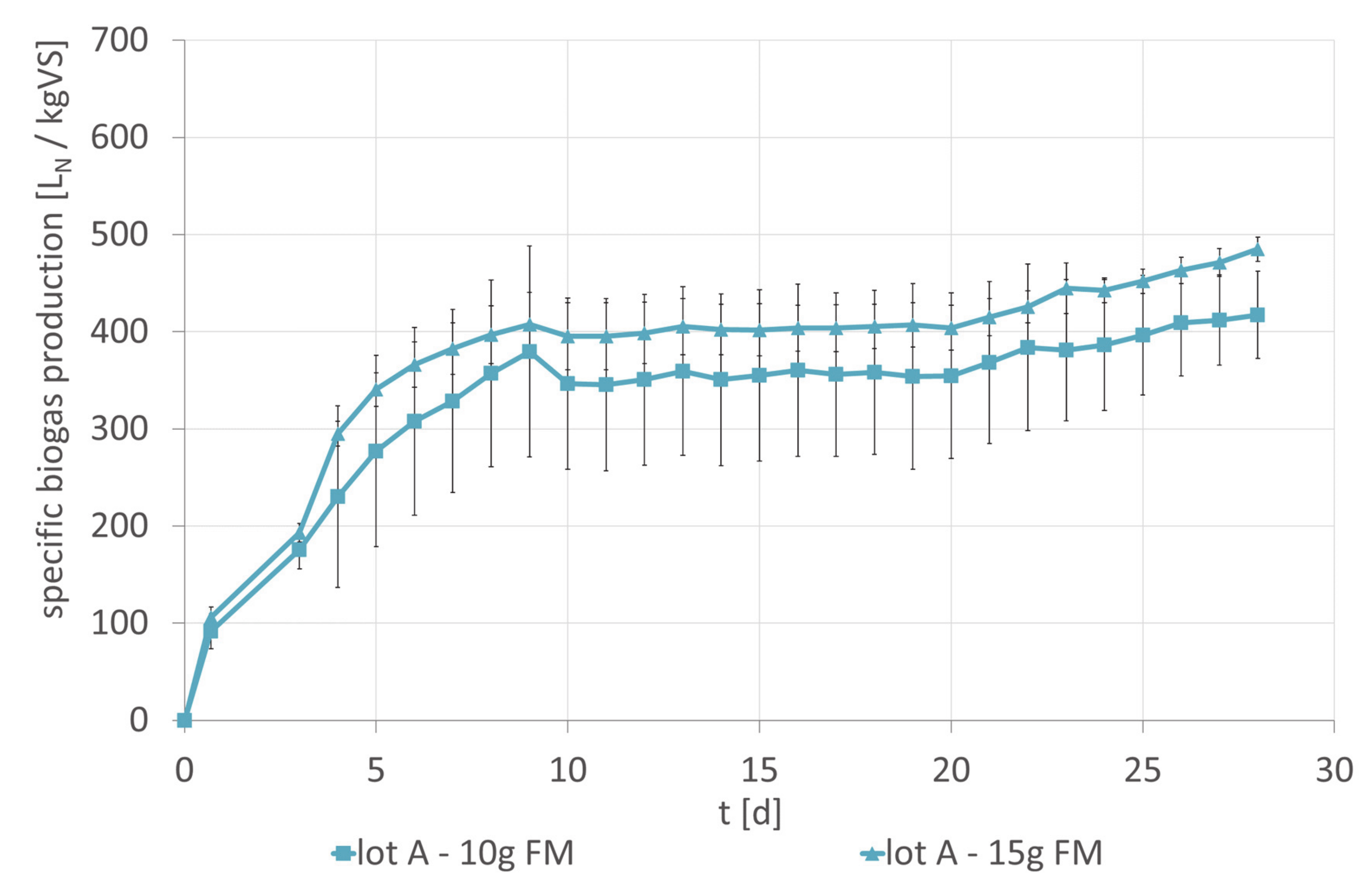
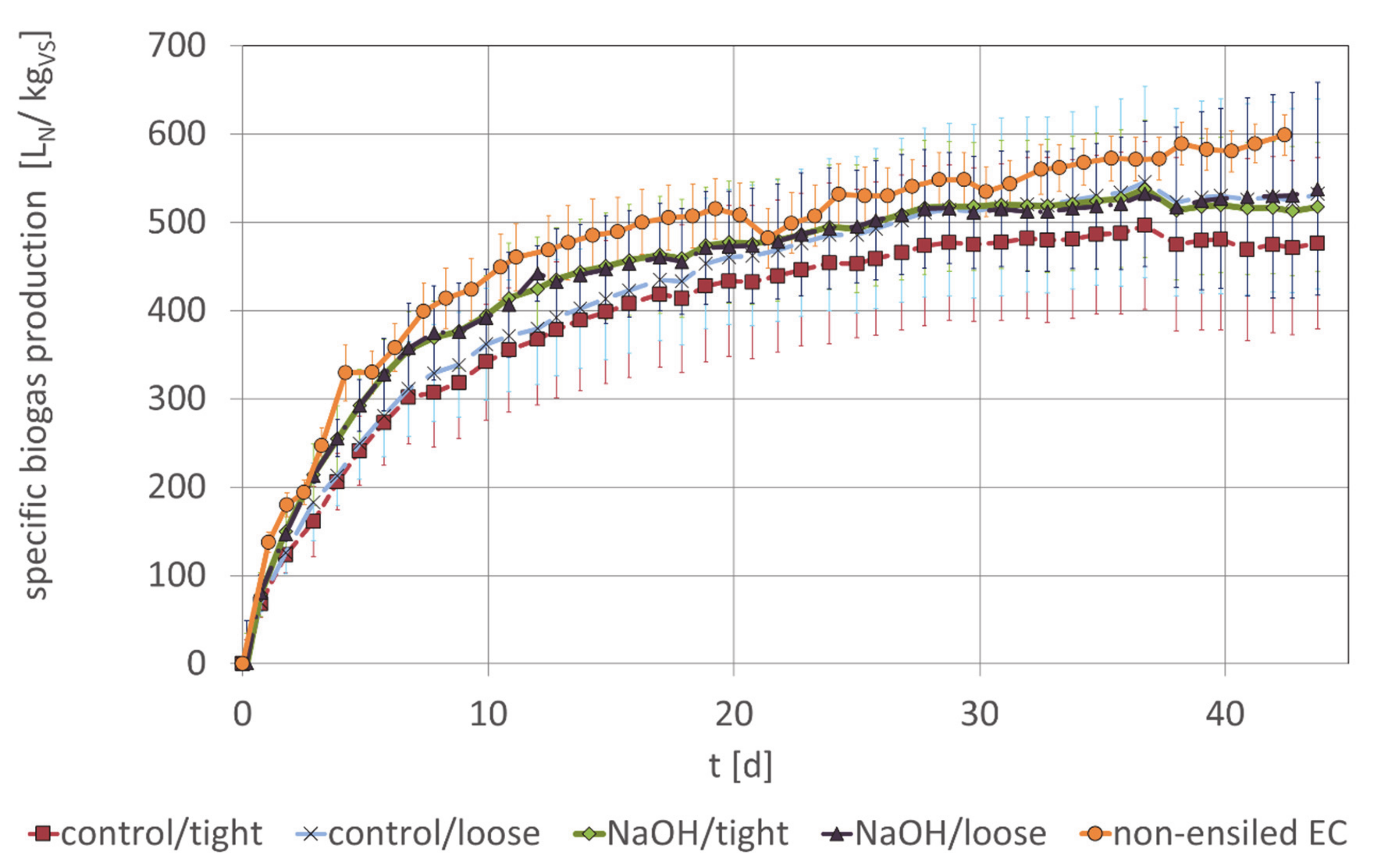
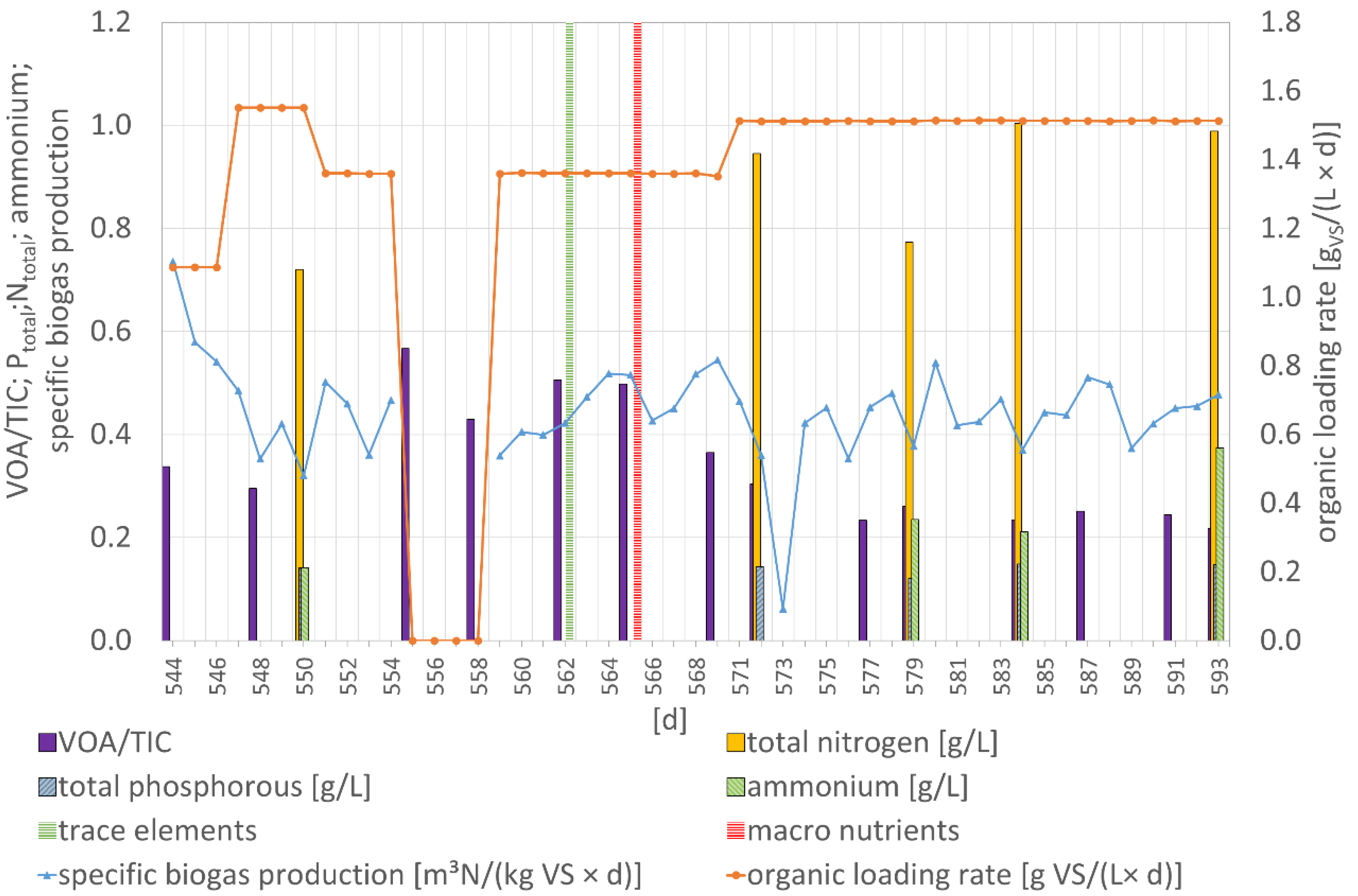

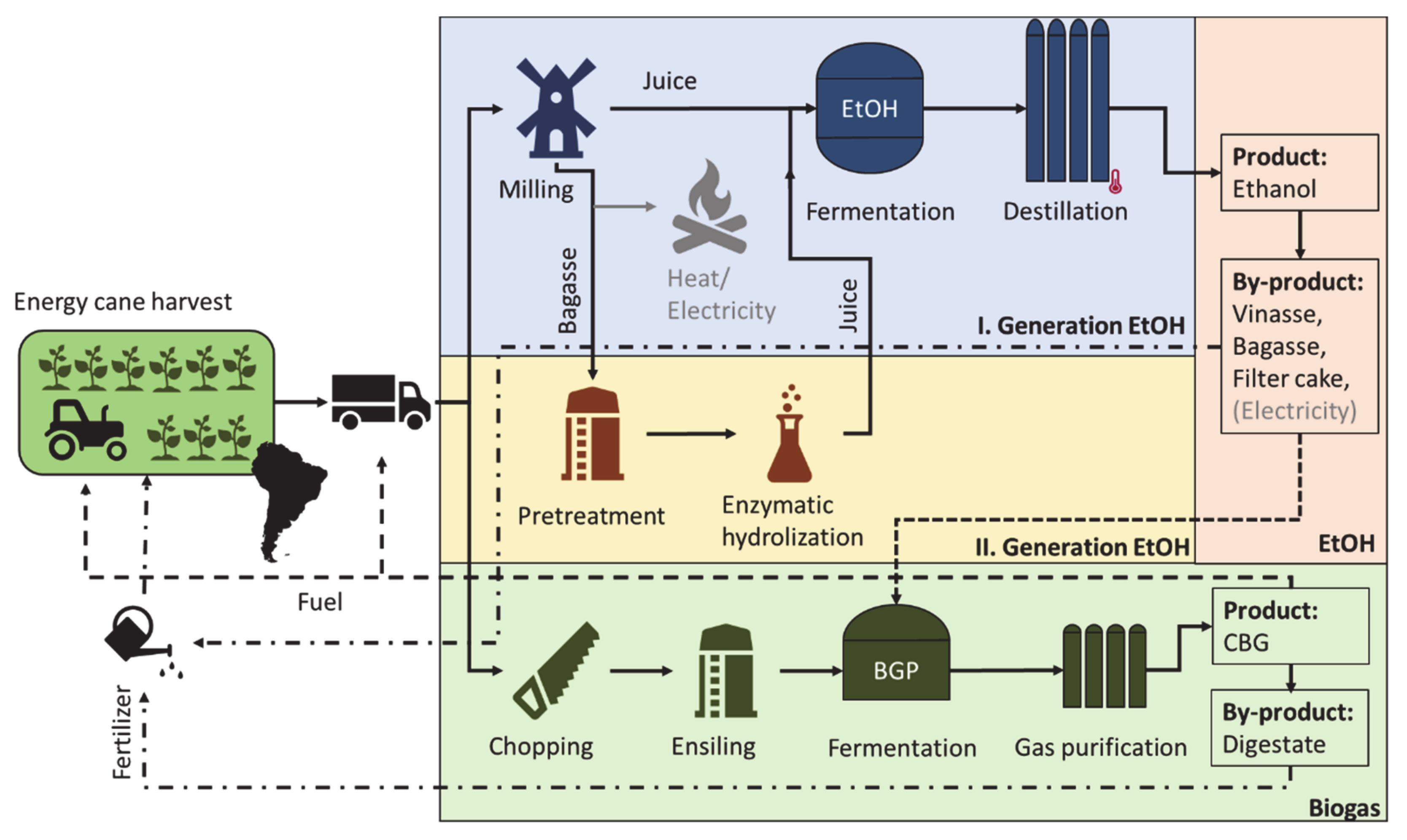
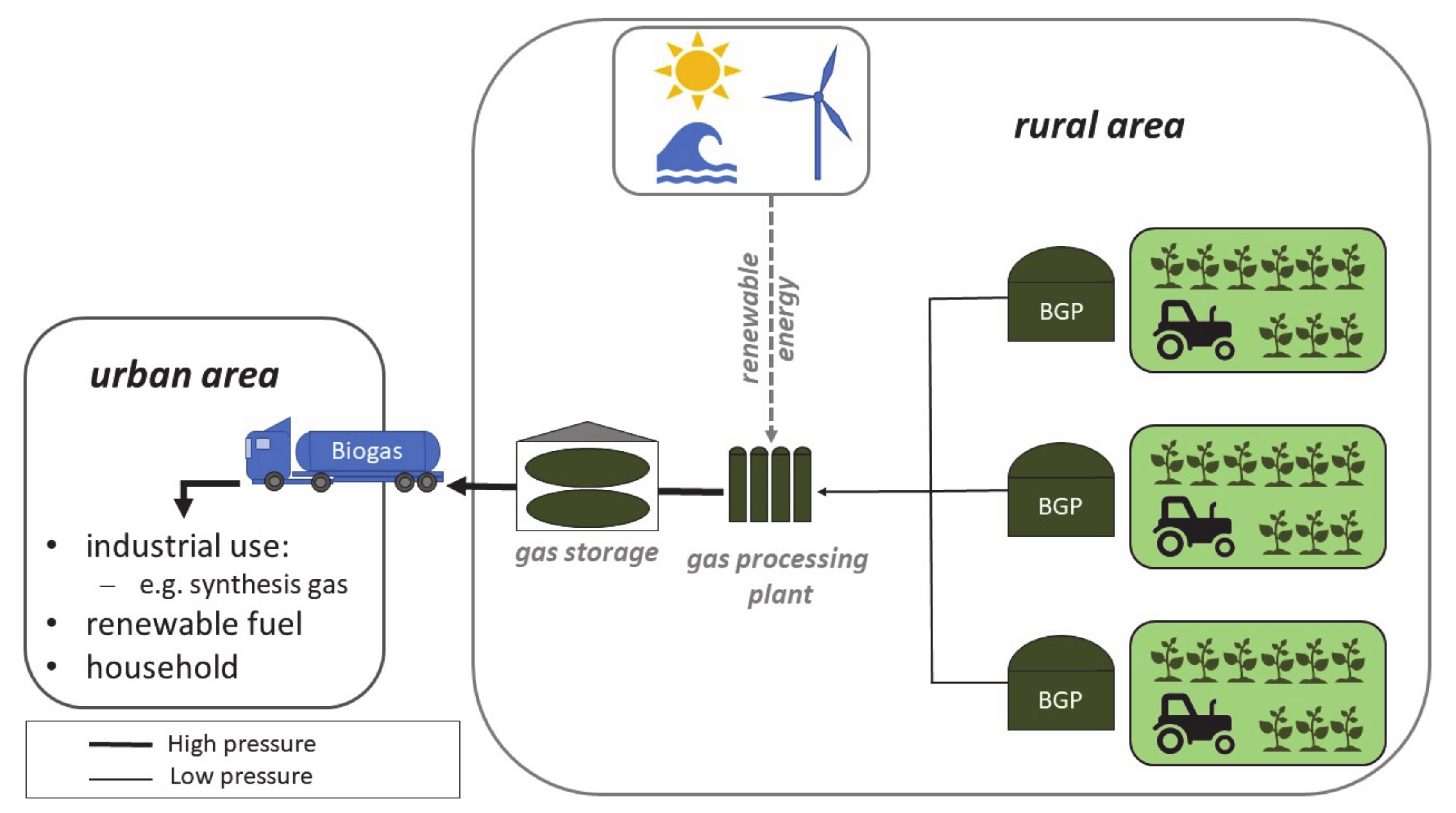
| Energy Cane Lot | Volumetric Organic Load (gVS/L) | Energy Cane (g) | Inoculum (g) |
|---|---|---|---|
| A | 7.1 | 10 | 240 |
| A | 10.6 | 15 | 235 |
| B | 10.5–12.5 | 8 | 200 |
| Substrate | Fresh Matter (FM) Yield (tFM/ha) | Dry Matter (DM) Yield (tDM/ha) | VS Yield (tVS/ha) | Source |
|---|---|---|---|---|
| Sugar cane | 92 | 27.59 | 26.4 2 | dos Santos et al. [18] |
| Sugar cane | 70 | 9 1 | 8.4 1,2 | Kim and Day [29] |
| Energy cane | 180 | 68.4 | 67.0 2 | dos Santos et al. [18] |
| Energy cane | 100 | 46.4 | 45.6 2 | Kim and Day [29] |
| Parameter | Value | Parameter | Value |
|---|---|---|---|
| C/N ratio | 107 | DM (%) | 29.2 |
| Nitrogen (%) | 0.15 | Ash content (%) | 0.8 |
| Carbon (%) | 16.5 | Crude protein (%) | 1 |
| 1 ADFVS (%) | 15 | Crude fiber (%) | 12.9 |
| 2 ADL (%) | 2.2 | Crude fat (%) | 0.6 |
| 3 aNDFVS (%) | 22.5 |
| Period | CH4 (%) | CO2 (%) | Specific Biogas Production (m3N/kgVS) | Organic Loading Rate (gVS/(L × d)) | VOA/TIC | Ntotal (g/L) | Ptotal (g/L) | NH4+ (g/L) |
|---|---|---|---|---|---|---|---|---|
| Days 544–561 | 52 | 29 | 0.35 | 1.05 | 0.41 | 0.72 | 0.14 | 0.24 |
| Days 562–573 | 55 | 24 | 0.43 | 1.40 | 0.42 | 0.95 | 0.14 | 0.21 |
| Days 574–593 | 55 | 29 | 0.44 | 1.51 | 0.24 | 0.92 | 0.13 | 0.37 |
| Substrate | Methane Yield min/mean (m3N/ha) | 1st gen. Ethanol Yield (L/ha) | 2nd gen. Ethanol Yield (L/ha) | Total Ethanol Yield (L/ha) | Biogas Energy Yield min/mean (MWh/ha) | Ethanol Energy Yield (MWh/ha) |
|---|---|---|---|---|---|---|
| Energy cane 1 | 13,392 3/16,204 4 | 4282 | 14,256 | 18,538 | 134 3/162 4 | 109 |
| Energy cane 2 | 9120 3/11,035 4 | 3400 | 12,991 | 16,391 | 91 3/110 4 | 96 |
| Sugar cane 1 | 5371 3/6499 4 | 6525 | 3782 | 10,307 | (54 3/65 4) | 60 |
| Sugar cane 2 | 1688 3/2042 4 | - | 4572 | 4572 | (17 3/20 4) | 27 |
| Parameter | Value | Parameter | Value |
|---|---|---|---|
| Operating time (d) | 334 | Operating time (h/a) | 8016 |
| Area related energy cane yield (tVS/ha) | 67 | Silage losses (%) | 20 |
| Organic loading rate (1.5 kgVS/(m3 × d)) | 1.5 | Methane yield (m3/tVS) | 200 |
| ηel (%) | 37 |
© 2020 by the authors. Licensee MDPI, Basel, Switzerland. This article is an open access article distributed under the terms and conditions of the Creative Commons Attribution (CC BY) license (http://creativecommons.org/licenses/by/4.0/).
Share and Cite
Hoffstadt, K.; Pohen, G.D.; Dicke, M.D.; Paulsen, S.; Krafft, S.; Zang, J.W.; da Fonseca-Zang, W.A.; Leite, A.; Kuperjans, I. Challenges and Prospects of Biogas from Energy Cane as Supplement to Bioethanol Production. Agronomy 2020, 10, 821. https://doi.org/10.3390/agronomy10060821
Hoffstadt K, Pohen GD, Dicke MD, Paulsen S, Krafft S, Zang JW, da Fonseca-Zang WA, Leite A, Kuperjans I. Challenges and Prospects of Biogas from Energy Cane as Supplement to Bioethanol Production. Agronomy. 2020; 10(6):821. https://doi.org/10.3390/agronomy10060821
Chicago/Turabian StyleHoffstadt, Kevin, Gino D. Pohen, Max D. Dicke, Svea Paulsen, Simone Krafft, Joachim W. Zang, Warde A. da Fonseca-Zang, Athaydes Leite, and Isabel Kuperjans. 2020. "Challenges and Prospects of Biogas from Energy Cane as Supplement to Bioethanol Production" Agronomy 10, no. 6: 821. https://doi.org/10.3390/agronomy10060821
APA StyleHoffstadt, K., Pohen, G. D., Dicke, M. D., Paulsen, S., Krafft, S., Zang, J. W., da Fonseca-Zang, W. A., Leite, A., & Kuperjans, I. (2020). Challenges and Prospects of Biogas from Energy Cane as Supplement to Bioethanol Production. Agronomy, 10(6), 821. https://doi.org/10.3390/agronomy10060821






